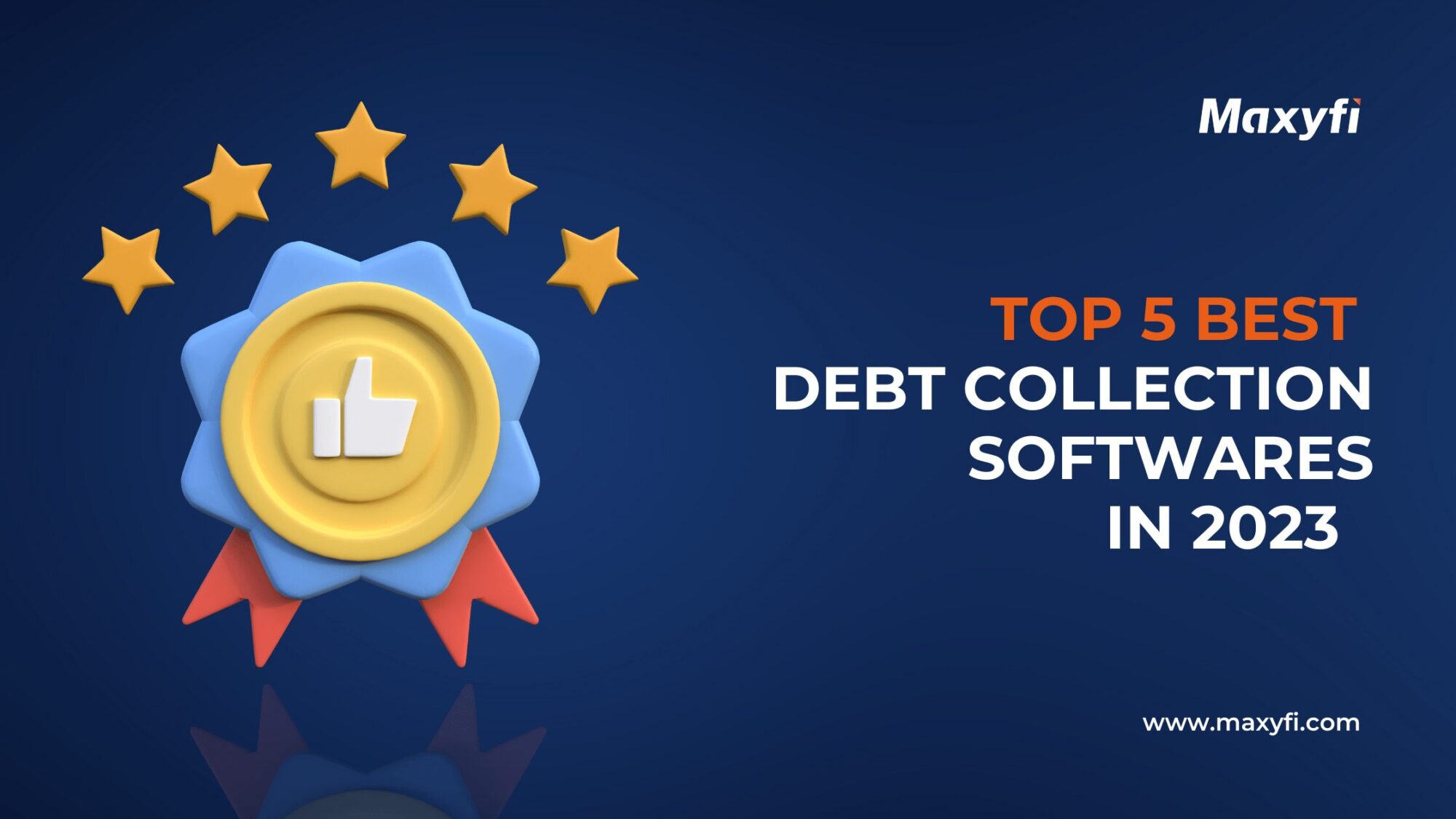Recover Payments Fast
A debt collection software plays a crucial role for businesses that don’t deal very well with unpaid invoices and cash flow management. Our team understands how difficult it becomes to recover payments while keeping customer relationships strong.
According to Mordor Intelligence, the accounts receivable automation market size is estimated at USD 3.40 billion in 2025, and is expected to reach USD 5.95 billion by 2030, at a CAGR of 11.84%. These numbers demonstrate businesses’ focus on optimizing their financial processes. Automated debt collection software helps companies manage finances and recover outstanding debts through automation. This technology turns chaos into cash flow.
Our team went through many solutions and selected the six best debt collection software options for 2025. This detailed analysis covers everything from features to pricing details that will help you make an informed decision based on your recovery needs.
Upflow
Upflow is a comprehensive Financial Relationship Management (FRM) solution that helps businesses go beyond basic invoice chasing to build stronger customer relationships and get paid faster. Instead of treating collections as a back-office task, Upflow equips finance teams with the visibility, tools, and collaboration they need to manage accounts receivable strategically. This debt collection software combines real-time insights, intelligent automation, and a customer-first payment experience to shorten payment cycles, improve cashflow predictability, and help teams scale without sacrificing customer relationships.
Upflow Key Features
The platform delivers powerful capabilities designed around relationship
management and collaborative workflows:
- Real-time Analytics Dashboard: Complete visibility into outstanding amounts, aging balances, DSO trends, and collection performance with actionable insights that helps teams understand not just what’s happening, but why customers aren’t paying
- Intelligent Automated Workflows: Multi-channel, personalized communication sequences that adapt based on customer behavior and payment history, with strategic levers to maintain professional relationships while driving payment action
- Modern Payment Portal: An enterprise-grade, white labeled solution built on proven infrastructure, offering multiple modern payment solutions and embedded payment capabilities that integrate directly into your website or app
- Automatic Cash Application: Intelligently matches incoming payments to invoices using AI algorithms, eliminating 90% of manual reconciliation work with smart exception handling
- Upflow AI: Advanced AI that analyzes payment patterns to provide root cause analysis of payment delays, personalized outreach, and automated workflow assistance
- Unlimited Team Collaboration: Assign tasks, tag teammates, and collaborate across finance, sales, and customer success teams without extra ERP licences
Upflow Pros
Users consistently report significant operational improvements:
- Dramatic DSO Improvement: Companies regularly see 10-15 day reductions in DSO, with users maintaining improvements even as invoice volumes scale
- Seamless Integration Ecosystem: Native, 3-click integrations with Netsuite, Chargebee, QuickBooks, Xero, Stripe Billing, Sage Intacct,Zuora, and Rillet ensures real-time data synchronisation without disrupting existing workflows
- Intuitive User Experience: B2C-level design simplicity applied to complex B2B payment workflows, enabling teams to adopt the platform quickly with minimal training required
- Massive Time Savings: Finance teams report 80% reductions in manual collection tasks, freeing up strategic capacity for higher-value work
- Cross-Department Alignment: The unlimited user model enables stronger collaboration between finance, sales, and customer success teams, creating unified customer experience
- Enhanced Team Collaboration: Professional, frictionless payment experience strengthens business relationships rather than straining them
Upflow Cons
- While Upflow excels in its target market, there are some considerations:
- B2B Focus: Purpose built for B2B relationships, so businesses with high-volume, low value B2C transactions may find the relationship management features less applicable to their use case
- Limited usefulness without ERP integration: While integrations are strong, businesses not using a supported accounting or billing system may not experience the full benefits.
- Some advanced features may require light onboarding or guidance
Tesorio
Tesorio takes a fresh look at debt collection. The company focuses on what they call “cash flow performance” that combines accounts receivable automation with financial visibility. This debt collection software connects your financial data across systems and helps predict payments to optimize cash flow management.
Tesorio key features
Tesorio streamlines collections and improves financial operations with these features:
- AI-Powered Cash Flow Management: The platform combines data from your finance operations to show your cash position in real time.
- Automated Collections Campaigns: You can create tailored email templates that trigger at strategic moments.
- Customer Payment Portal: The platform gives customers a secure, easy-to-use portal to pay invoices, resolve disputes, view invoices, and track payment history.
- Cash Application Agent: The system matches payments with invoices automatically. This reduces manual reconciliation work and makes cash application more accurate.
- Bank Transaction Management: Users get a single view of all bank accounts and transactions for combined financial reporting.
- Integration Capabilities: The system connects with ERPs, CRMs, billing systems,and banking platforms.
Tesorio pros
- DSO Reduction: Companies see their Days Sales Outstanding drop by 33 days on average.
- Improved Productivity: One company cut time spent on lower-priority accounts from 25% weekly to under 2 hours.
- Live Analytics: Dashboards and reports turn raw data into applicable information for better decisions.
- Cash Flow Visibility: Real-time insights help make informed cash management decisions. Some companies have cut their forecasting cycles from over a week to just hours.
Tesorio cons
- Learning Curve: Some users find it challenging to switch from spreadsheets or other softwares, especially when setting up complex automation workflows.
- Unidentified Payment Handling: A user mentioned that Tesorio sometimes misses payments when the referenced invoice number is no longer open.
- Dashboard Limitations: One user said that “the widgets in the insights page could allow more data from a timing perspective than it currently does”. This points to some reporting restrictions.
- Email Functionality Issues: Some users reported that “adding (cc) another email address is not working”. This affects communication with customers and team members.
- Occasional Downtime: Users mentioned that “once in a while the tool goes down”. They noted these issues usually get fixed within hours.
Tesorio stands out among debt collection software options for companies that want better cash flow visibility and automated collections. Mid-sized to enterprise companies looking to make their AR function more strategic will find it most useful. But smaller companies that need a dedicated collections tool with lots of customization might want to look at other solutions.
HighRadius
HighRadius presents itself as an AI-powered debt collection solution built for large enterprises. The platform optimizes end-to-end accounts receivable processes through its integrated receivables suite that combines multiple collection features.
HighRadius key features
- Agentic AI Technology: HighRadius uses what they call “Agentic AI” that goes beyond simple task automation. The system actively adapts to live changes in customer behavior.
- AI-Based Risk Assessment: The platform uses artificial intelligence to assess customer creditworthiness and reduce exposure to high-risk accounts.
- Automated Collection Workflows: The platform creates priority lists using specialized algorithms. These analyze customer accounts with 20+ variables and 12 months of payment history.
- Integrated Dialer: The platform’s integrated dialer lets collection analysts make calls while viewing past interaction summaries.
- Complete Analytics: FreedaGPT Insights creates quick, accessible reports and dashboards through simple English prompts.
- Multi-Source Integration: The platform connects to multiple ERPs, credit agencies and billing systems worldwide. It works with multiple AP portals to deliver invoices by accessing customer portals and tracking their status.
HighRadius pros
- Reduction in Past Due: Companies using the platform report 20% fewer past-due accounts. Some businesses can spot payment issues 30 days before they happen.
- Boosted Collector Productivity: Teams reach 5X more customers thanks to automation capabilities. The platform claims to boost collector productivity by 30%.
- Advanced AI Capabilities: The system predicts payment delays 30 days ahead using its advanced AI capabilities.
- Time Savings: The platform’s automation helps users save 1000+ hours yearly on collections activities.
HighRadius cons
- Enterprise Focus: The platform is designed mainly for large enterprises. Small or mid-market businesses looking for simpler solutions might find it overwhelming.
- Complex Implementation: Setting up this complete platform needs significant time and resources compared to simpler options.
- Potential Learning Curve: The sophisticated AI capabilities and feature-rich platform might take longer to master than basic collection tools.
- Potential Integration Challenges: The platform offers many integrations, but connecting multiple systems might create technical issues for some organizations.
- Possible Over-Automation: Businesses preferring manual control over collections or customer communications might not like the heavy AI focus.
HighRadius definitely offers powerful debt collection automation tools. Organizations should assess whether its enterprise approach matches their needs. Large companies with complex receivables processes will find useful automation tools that can cut past-due accounts and optimize productivity. However, smaller businesses or those wanting straightforward solutions might find the extensive features too complex.
Netsuite Dunning
NetSuite’s debt collection approach gives businesses a built-in solution right inside their existing ERP system. The Dunning Letters SuiteApp helps companies track overdue invoices and send automated payment reminders.This works as a complete debt collection software solution within the broader
NetSuite ecosystem.
NetSuite Dunning key featuresThe NetSuite Dunning module offers several powerful tools to optimize accounts receivable management:
- Automated dunning process: The system assesses customers,invoices, and invoice groups to determine which ones need dunning letters based on preset procedures.
- Customizable procedures: Users can set up specific dunning levels and choose when to send letters at key points like 30, 60, or 90 days overdue.
- Multi-language templates: Companies can adapt dunning letter templates to their needs and create versions in different languages to reach customers of all types.
- Evaluation workflows: The platform makes it easy to set up workflows that decide which customers go through the dunning process, with options to send notices manually or automatically.
- Detailed dashboard: A single view shows important information like overdue receivables, letters sent recently, average payment times, and accounts with paused dunning.
NetSuite Dunning pros
Having dunning management right inside NetSuite brings clear benefits:
- Unified environment: The native SuiteApp keeps all financial data in one system without needing third-party tools.
- Well-laid-out collection approach: The platform gives customers specific dunning levels based on how late they are, which creates a clear path to recover unpaid balances.
- Quick record-keeping: Teams can document all collection activities in the customer record to build a detailed history of interactions.
- Pre-configured reporting: Built-in reports help businesses track overdue accounts and collection activities to stay on top of their progress.
- Flexible communication options: Users can send dunning letters by email or print them out, matching their customers’ communication needs.
NetSuite Dunning cons
Compared to tools like Upflow, Tesorio, and HighRadius, NetSuite Dunning has some key limitations:
- Email capacity restrictions: The Dunning Email Sending Queue can only handle 100 emails at once, which might slow down businesses with many customers.
- Email Tracking Limitations: The Dunning Letters SuiteApp can’t detect bounced emails. This leaves you in the dark about whether recipients got your messages
- Workflow Complications: The workflow-based dunning depends heavily on SuiteFlow (NetSuite’s automation tool).This needs technical expertise and relies on saved searches that can break the entire process if changed
- Limited dunning levels: Each procedure can only have 15 dunning levels. This might not be enough for companies that need complex collection steps.
- Printing constraints: The Dunning PDF Printing Queue creates just 100 letters at a time, which can slow down larger operations. File size limitations: PDF files can’t be bigger than 5MB. Larger files split into multiple attachments automatically, which can confuse recipients.
- Currency requirements: The Dunning Letters SuiteApp only works with accounts that have the Multiple Currencies feature turned on, leaving out single-currency businesses.
Invoiced
Invoiced takes a different approach to debt collection. Unlike most platforms that focus only on collections, it automates the entire invoice-to-cash process. They try to make the payment processes smoother with customer portals, multi-channel communications, and workflows.
Invoiced key features
Invoiced offers a complete set of tools to optimize the invoice-to-cash process:
- Automated Collections: The system takes care of repetitive tasks such as sending invoices, payment reminders, and matching payments to invoices. This reduces manual work and errors.
- Smart Chasing: This automated follow-up system changes outreach based on how clients respond.
- CashMatch AI: The platform’s artificial intelligence automatically settles payments with outstanding invoices.
- Customer Portal: Customers can view billing history, pay invoices online, and set up auto-payments through a self-service portal.
- Multi-Payment Support: The platform accepts various payment methods including credit cards, ACH, BACs, direct debit, SEPA, and other alternatives.
Invoiced pros
Businesses have seen significant benefits after using Invoiced:
- Easy-to-use Interface: The platform has clean navigation and simple invoice creation.
- Time Efficiency: Finance teams can focus on strategic activities because A/R processes are automated.
- Better Customization: Users can customize invoice templates with their branding, logos, and personal messages.
- Strong Security: Built-in encryption and compliance features keep sensitive financial data safe.
- Extensive Integration: The software works with popular accounting and ERP systems like QuickBooks, Xero, Sage and other financial platforms.
Invoiced cons
Invoiced has some limitations despite its strengths:
- Learning Curve: Setting up automation workflows can be challenging at first because of the many configuration options.
- Limited Email Tracking: The platform doesn’t offer advanced email tracking to check if customers have opened communications, unlike some competitors.
- Implementation Complexity: Connecting Invoiced to ERP systems sometimes needs technical expertise that smaller businesses might not have, even with available documentation.
- Documentation Gaps: Some users need more implementation help than what’s available in standard documentation.
Your business might find great value in Invoiced if late payments are a challenge and you spend too much time on manual follow-ups and reconciliation. All the same, smaller businesses with simple collection needs or companies looking for AI-powered predictive features might do better with other alternatives
Versapay
Collaborative accounts receivable management is the foundation of Versapay’s debt collection software. The platform connects businesses with their customers to solve payment issues.
Versapay key features
- Zero-touch collection: The system targets customers before payments become late, which reduces follow-up needs
- Real-time communications: Cloud-based chat lets teams handle disputes right away
- Automated notifications: Teams can set up more than 150 custom notifications to focus on customers who need help with payments
- Detailed collection management: The platform offers tools to track, prioritize and simplify payment follow-ups
- Multiple payment processing options: Users can pay through credit cards, ACH transfers, digital wallets, and checks
- ERP integration: The system connects smoothly with Microsoft Dynamics, NetSuite, and Sage Intacct
Versapay pros
Companies using Versapay see many benefits:
- Exceptional ease of use: Teams rate the platform good for usability. You don’t need special software knowledge to use it Effective collections automation: Automatic notifications save time on payment follow-ups
- Good customer experience: Clients see everything in one easy-to-use portal – invoices, payment history, and disputes
- Internal efficiency: Teams answer billing questions almost instantly through built-in communication features
Versapay cons
Versapay has some limitations to think over:
- Payment limits: This is the biggest problem for businesses handling large transactions
- Support availability: The helpdesk lacks a chat function and topic search feature
- System performance: Large data loads can slow down the system
Interface limitations: Users want better search options and simpler navigationVersapay proves itself as a strong option for collaborative accounts receivable management. Yet, businesses should weigh its reporting limits and payment restrictions before making the switch
FAQs
Q1. What are the key benefits of using debt collection software?
Debt collection software automates accounts receivable processes, reducing manual work and improving cash flow. It typically offers features likeautomated reminders, payment tracking, and analytics to help businesses collect payments faster and more efficiently.
Q2. How does AI enhance debt collection software?
AI in debt collection software can prioritize accounts based on risk, predict payment behavior, and automate communication with customers. This allows collectors to focus on high-value accounts and use data-driven strategies to improve collection rates.
Q3. What should businesses consider when choosing debt collection software?
Businesses should consider factors like integration capabilities with existing systems, customization options, pricing structure, ease of use, and specific features like multi-channel communications or AI-powered analytics. It’s alsoimportant to evaluate customer support and implementation processes.
Q4. How can debt collection software improve customer relationships?
Good debt collection software provides a more professional and consistent approach to collections. It can offer customers self-service portals, flexible payment options, and clear communication, which can lead to better experiences and stronger relationships even during the collection process.
Q5. What is the typical return on investment for debt collection software?
While ROI varies, many businesses report significant improvements after implementing debt collection software. Common benefits include reduced Days Sales Outstanding (DSO), increased productivity of collection teams, and lower bad debt write-offs. Some companies have seen DSO reductions of 11-15 days and productivity increases of 30% or more

































